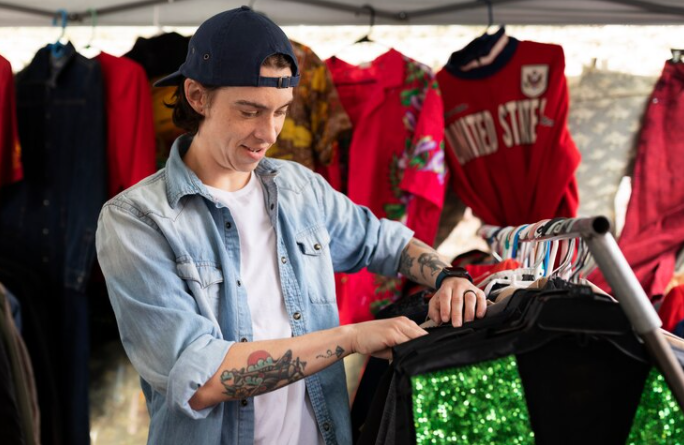In an era where environmental consciousness intertwines with everyday choices, the fashion industry stands at a crossroads, witnessing a profound shift towards sustainability. As consumers increasingly seek eco-friendly alternatives, the demand for sustainable apparel has surged. However, the journey towards a more responsible and ethical fashion landscape is not without its challenges. This article delves into the intricate web of obstacles that the sustainable apparel industry faces, ranging from the pervasive influence of fast fashion to the intricacies of supply chain management and the delicate balance of material selection. Join us as we unravel the complexities that underscore the pursuit of sustainable fashion and explore strategies to overcome these hurdles for a greener, more conscientious future.
The Fast Fashion Conundrum
In the realm of sustainable apparel, the shadow of fast fashion looms large, casting a pervasive influence that has long defined the industry’s landscape. Fast fashion, characterized by rapid production cycles and an emphasis on low-cost garments, has become synonymous with environmental degradation. The industry’s insatiable appetite for constant turnover of trends and inexpensive clothing has significant consequences for the planet.
One of the paramount challenges lies in the environmental toll exacted by the fast fashion model. The expedited pace of production leads to increased resource consumption, excessive waste, and a staggering carbon footprint. Garments designed for obsolescence, a strategy known as planned obsolescence, contribute to the throwaway culture that plagues the fashion industry. Consumers, often enticed by the allure of low prices, inadvertently contribute to a cycle of overconsumption, discarding garments after only a few uses.
As we navigate the complexities of sustainable apparel, addressing the fast fashion conundrum emerges as a critical task. The challenge extends beyond production methodologies to the profound task of altering consumer perceptions and behaviors. Education becomes paramount, as consumers must be empowered to recognize the true cost of fast fashion and make informed choices that align with a sustainable future. In the chapters that follow, we will unravel the intricate threads of sustainable fashion, exploring not only the challenges but also the innovative solutions that promise a departure from the fast fashion paradigm.
Supply Chain Complexities
The journey towards sustainable apparel encounters its second major hurdle in the intricate web of supply chain complexities. Sourcing materials, manufacturing, and distribution are integral components, each laden with challenges that demand conscientious navigation.
Sustainable sourcing grapples with the demand for transparency and ethical practices throughout the supply chain. As consumers increasingly scrutinize the origins of their garments, brands face the challenge of ensuring that every step aligns with environmentally friendly and socially responsible practices. Achieving traceability from raw materials to the finished product poses a formidable task, requiring collaboration between brands, suppliers, and manufacturers.
Supply chain management becomes a balancing act, as brands strive to minimize their environmental impact while maintaining operational efficiency. The dichotomy between sustainability and cost-effectiveness often raises dilemmas, necessitating a careful examination of each link in the supply chain.
Collaboration emerges as a key strategy to navigate these complexities. Brands forging partnerships with suppliers committed to sustainable practices can create a domino effect, influencing positive change across the industry. As we unravel the intricacies of the sustainable apparel supply chain, it becomes evident that innovation and cooperation are vital to overcome these challenges and pave the way for a more sustainable future in fashion.
Material Selection Dilemmas
The heartbeat of sustainable apparel lies in the careful selection of materials, yet this presents the third formidable challenge. Striking a balance between ecological responsibility, consumer expectations, and the practicalities of production is a delicate dance that defines the industry’s commitment to sustainability.
The challenge begins with the plethora of material options available, each carrying its own set of environmental implications. From organic cotton to recycled polyester, sustainable materials present both opportunities and dilemmas. Designers must navigate trade-offs between environmental impact, functionality, and aesthetics, ensuring that the chosen materials align with the brand’s sustainability goals.
The innovation frontier plays a crucial role in overcoming material selection dilemmas. Advancements in textile technology offer promising alternatives, with researchers exploring groundbreaking solutions such as lab-grown fabrics and bioengineered materials. However, implementing these innovations on a large scale requires significant investment and a willingness to embrace change within the industry.
Consumer education also plays a pivotal role in addressing material selection challenges. Brands must transparently communicate the environmental benefits and trade-offs associated with different materials, empowering consumers to make informed choices that align with their values.
In the quest for sustainable apparel, the choices made in material selection become a defining factor. This chapter unravels the complexities inherent in this process and explores how the industry can navigate the material selection dilemmas to create fashion that is not only stylish but also environmentally conscious.
Consumer Awareness and Behavioral Change
The success of sustainable apparel hinges not only on the decisions made within the industry but also on the pivotal role consumers play. Chapter 4 delves into the multifaceted challenge of fostering awareness and driving behavioral change.
In an era of information overload, the challenge is to cut through the noise and effectively communicate the importance of sustainable fashion. Many consumers remain unaware of the environmental and social impact of their clothing choices. Educating the public becomes a paramount task, demanding creative and engaging strategies to convey the urgency of adopting sustainable practices.
Beyond awareness, the challenge extends to altering consumer behavior. Habituated to the convenience and allure of fast fashion, individuals must be encouraged to rethink their approach to fashion consumption. Initiatives promoting mindful shopping, capsule wardrobes, and clothing longevity gain significance as the antidote to the throwaway culture perpetuated by fast fashion.
Brands find themselves at the forefront of this paradigm shift, tasked with crafting marketing messages that resonate with consumers’ values. Transparency, authenticity, and relatability become key components of campaigns aiming to inspire a shift towards sustainable choices.
As we navigate the complexities of consumer awareness and behavioral change, it becomes evident that a collective effort from both industry players and consumers is indispensable. This chapter explores strategies to bridge the gap between awareness and action, steering the fashion narrative towards a more sustainable and conscious future.
Regulatory Landscape and Industry Standards
In the pursuit of sustainable apparel, Chapter 5 explores the regulatory framework and industry standards that shape the path toward a greener and more ethical fashion industry.
The challenges within the regulatory landscape are multifaceted. While there is a growing recognition of the need for standardized environmental and ethical guidelines, the lack of a unified global approach poses obstacles for brands operating across borders. Navigating a patchwork of regulations demands flexibility and adaptability from sustainable apparel producers.
Industry standards play a crucial role in defining what constitutes “sustainable” within the fashion realm. However, the dynamic nature of sustainability requires continuous evolution of these standards to keep pace with technological advancements and changing consumer expectations. This chapter delves into the challenges faced by brands in aligning with evolving standards and the need for a collaborative effort to establish benchmarks that promote sustainability without stifling innovation.
The role of certifications, such as organic, Fair Trade, or B Corp, is explored as a means to provide consumers with tangible indicators of a brand’s commitment to sustainability. However, challenges such as certification fatigue and the need for harmonization between different standards highlight the complex landscape within which brands must operate.
Paving the Path to a Sustainable Future
In wrapping up our exploration into the challenges of sustainable apparel, it’s clear that the path to a more conscientious fashion industry is nuanced and essential. From the influence of fast fashion to the complexities of supply chains and consumer behaviors, each challenge presents opportunities for innovation and collaboration.
In this context, Efesto stands out, illustrating how these challenges can be navigated with commitment. Their focus on eco-friendly materials, ethical manufacturing, and supply chain transparency reflects the core values of a sustainable brand. Thier efforts extend beyond the garments themselves, encompassing thoughtful choices like biodegradable packaging, recycled paper labels, and a meaningful collaboration with Stripe.
Efesto serves as a practical example of a brand actively contributing to a sustainable future. While not without its challenges, the brand’s initiatives contribute positively to the broader narrative of responsible fashion. In choosing sustainable companies, consumers are aligning with a brand that takes meaningful steps towards sustainability, encouraging a collective effort to shape a more responsible fashion industry.





